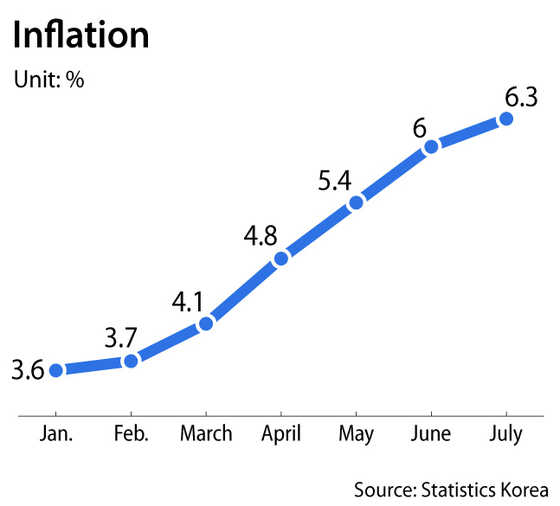Korean inflation at a 24-year high in July as most prices rise
![A consumer shops for Napa cabbage in the fresh produce section of a grocery store in Daegu on Tuesday. Napa cabbage prices rose 72 percent year-on-year. [YONHAP]](https://koreajoongangdaily.joins.com/data/photo/2022/08/02/e58c9c10-32fa-42a6-9313-0905fa92533a.jpg)
A consumer shops for Napa cabbage in the fresh produce section of a grocery store in Daegu on Tuesday. Napa cabbage prices rose 72 percent year-on-year. [YONHAP]
Prices in Korea rose across the board, with everything from manufactured goods to electricity becoming more expensive, according to Statistics Korea.
It was the second consecutive month in which inflation was above 6 percent.
Vegetable prices were up 25.9 percent on year, manufactured goods 35.1 percent, diesel 47 percent, gasoline 25.5 percent, kerosene 80 percent and LPG 21.4 percent.
Napa cabbage prices surged 72.7 percent, cucumbers 73 percent, lettuce 63 percent and green onions 48.5 percent.
Agriculture, livestock and fishery prices overall were up 7.1 percent year-on-year. Fresh produce prices rose 13 percent, pork 9.9 percent and imported beef 24.7 percent.
Services were 4 percent more expensive on year, the cost of dining out rising 8.4 percent, a 30-year high.
Electricity and gas costs rose 15.7 percent on year. Electricity rates were upped 5 won per kilowatt-hour last month, which is a 4.3 percent increase.
Prices rose in all major categories, though some individual items became cheaper. The price of rice fell 14.3 percent, sweet potatoes 30.1 percent, eggs 10.8 percent, apples 13 percent, pears 14 percent and beans 12.4 percent.
In terms of manufactured goods, the price of computers was down 3.3 percent, vacuum cleaners 8.1 percent and rice cookers 12 percent.
The statistics agency said inflation will probably ease this month, although it is likely to remain above 6 percent.
External factors, such as the surge of international oil prices, are easing, said Eo Woon-sun, a Statistics Korea official. He also noted that the base effect would lower inflation as prices were high in August and September last year.
The statistics official said month-on-month increases have been moderating and indicated that at this pace it is not likely that inflation will break 7 percent.
On-month price increases were 0.5 percent in July, 0.6 percent in June and 0.7 percent in May. Core inflation, which excludes energy and food, was 3.9 percent in July.

Bank of Korea Governor Rhee Chang-yong told lawmakers on Monday that if the central bank increases rates, it is likely to be in quarter-point increments rather than half-point jumps.
The governor told lawmakers that as consumer prices are likely to continue to rise for the time being, there's a need to raise interest rates several more times.
Rhee said inflation will likely break the 4.5 percent projection that the central bank made in May, while the economy will likely grow at a slower pace than the 2.7 percent the bank forecast.
"While it's difficult to predict overseas factors," Rhee said. "There's a strong possibility of raising the interest rates by 25 basis points each time."
Last month, for the first time, the bank raised rates by 0.5 percentage points. It has three more meetings where it could raise the base rate this year, including one on Aug. 25.
Korea's key interest rates are lower than those in the United States for the first time in two years. The rate is 2.25 percent whereas the U.S. Federal Funds rate is between 2.25 and 2.50 percent.
Higher interest rates in the U.S. could lessen the appeal of Korean investments, which could lead to the exodus of foreign capital.
The central bank has been aggressively raising rates since August last year. The base rate has been raised six times from a historic low of 0.5 percent in July last year to 2.25 percent.
According to the bank, every time rates are raised 0.25 percentage points, consumption in the private sector shrinks at most 0.15 percentage points.
Following the announcement of July's inflation figures, stocks sank, with the Kopsi down about 0.5 percent.
BY LEE HO-JEONG [lee.hojeong@joongang.co.kr]










with the Korea JoongAng Daily
To write comments, please log in to one of the accounts.
Standards Board Policy (0/250자)